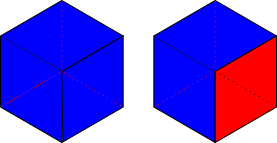Copyright © University of Cambridge. All rights reserved.
'Russian Cubes' printed from https://nrich.maths.org/
Show menu
Well done to Alex from Stoke-on-Trent Sixth Form College, and Anurag from Queen Elizabeth's Grammar School, Horncastle, for their solutions to this problem.
Here is Alex's explanation for the first part of the problem:
Consider one of the sides painted blue, and rotate the cube so that this side is on top. Out of the four sides that touch it (and are rotationally symmetrical), at most three of those are red because there are three red and three blue, therefore at least one of these is blue. Rotate the cube so that the top and a selected blue side is facing. All combinations must be rotatable to this position, so considering the uncoloured sides is sufficient to deduce the number of combinations. Out of the four remaining sides, one must be coloured blue and the other three coloured red. This reduces the problem to four possible combinations, each found by colouring a different remaining face blue. Two of these result in three coloured faces that share a vertex, and the other two form a lines of colour that bends around the cube with another line of the other colour in the same shape. Both of these are the same if the colours are swapped over, so there are exactly two combinations.

This diagram shows the two possibilities. The left cube has three blue faces meeting at a vertex (and three red faces on the other side of the cube). The right cube has blue faces on the front, top, and back of the cube.
Anurag explained very clearly how Cath can ensure the two cubes are the same:
James has only one possible move first. This is because the cube could be rotated so the bottom cube is always blue. If Cath now wants the shared vertex cube, she colours the opposite side to whichever James paints. This will always produce the desired result as, in this cube, no opposite sides are the same colour. By painting the opposite side red, Cath removes James's ability to colour it blue, thus forcing him to paint a cube where similar sides meet at a vertex.
However, Cath cannot force a cube in which similar sides are in a strip. In a strip there must be two similar sides opposite each other (they share no vertices, and so whatever the third side is, a strip is formed). Cath must avoid painting any side opposite to a blue. This is so, on James's last move, his only two options are the only sides opposite his other, blue coloured side. So, on her first move, Cath must paint a side adjacent to the side James painted blue side. But if James now paints the sides opposite to Cath's, Cath cannot make two of her reds opposite each other, which she too must need. Which means Cath cannot force the second type of cube, so to ensure both were the same she would have to make sure the first cube was the shared vertex type.